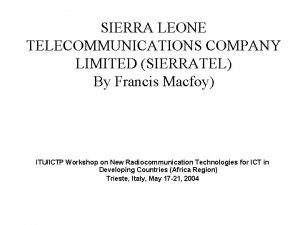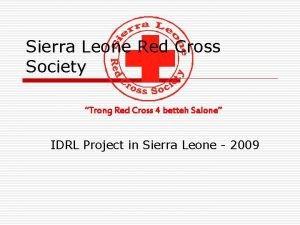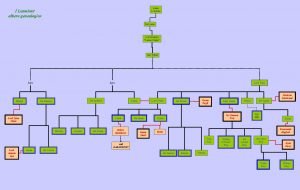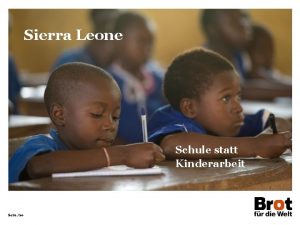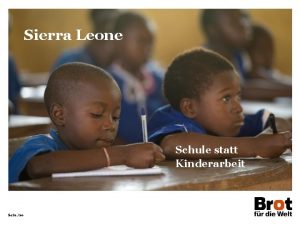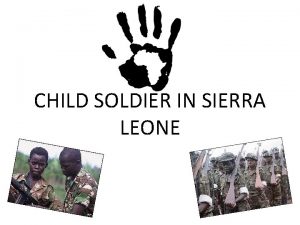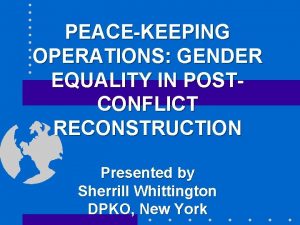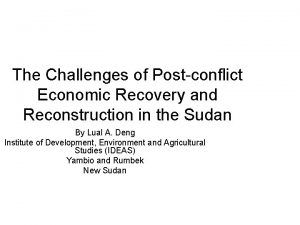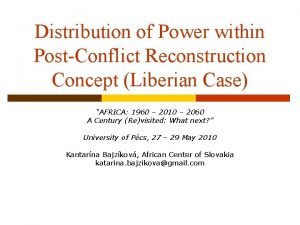Gender and postconflict reconstruction in Sierra Leone Megan















- Slides: 15

Gender and post-conflict reconstruction in Sierra Leone Megan Mac. Kenzie Victoria University of Wellington, New Zealand

Central questions � Why, if women participated as soldiers, were they largely ignored in mainstream accounts of the conflict and overlooked in the DDR process? � What gendered stereotypes might influence post -conflict policy-making? � Is post-conflict a good time to address gender inequality? � Why does gender sensitivity matter when it comes to conflict and post-conflict policymaking? � How can we improve conflict programs by acknowledging gender?

Stereotypes about ‘third-world’ women and war 1. 2. Women are not major actors in war When war is over, women are happy to ‘return to normal’

Are females ONLY victims in war? What are the sources of this stereotype? 1. 2. 3. 4. Sexual violence emphasis. Women removed from policy-making process. Literature and research: Women as naturally peaceful and averse to risk. Violent women are typically seen as exceptions or even monsters. (Sjoberg 2007)

The ‘problem’ with female soldiers � Challenge a particular understanding of social and gender order -power, marriage, children, ‘legitimate’ relationships � Disrupt gendered binaries associated with war (male warrior/female victim) and dominant myths about war (peaceful women, violent men)

Some background on female soldiers in SL the number of females soldiers was much higher than existing estimations. 30 -50% multiple and diverse roles female soldiers were often perpetrators and victims Distinction between combat and support roles (combatants as ‘real’ soldiers) Sexual violence rates extremely high amongst female soldiers

Responses to question: what did you do during the conflict? “leading lethal attacks” “screening and killing prorebel civilians” “combatant” “poison/inject captured war prisoners with either lethal injection or acid” “I trained with [the AFRC] bush camp how to shoot a gun” “fighting” “killing and maiming progovernment forces and civilians” “gun trafficking” “killing” “planning and carrying out attacks on public places” “do execution on commanders of my age group” “murdered children”

What makes women soldiers and why is there resistance to this title? Various titles given to female soldiers: ‘camp followers, ’ ‘abductees, ’ ‘sex slaves, ’ ‘domestic slaves, ’ or ‘girls and women associated with the fighting forces’ and ‘vulnerable groups associated with armed movements’

Analysis � The importance of combat duty to the soldier title � Reclassification of female soldiers as some form of victim: abductees, camp followers, bush wives � Ignoring/prioritizing diverse labor required to sustain warfare � Ignoring sexual slavery as a wartime currency and required duty for many women � This lack of attention to gender resulted in inefficient DDR policy-making

What’s in a name? Depoliticization of women’s activities and labor during war Ignoring or re-categorizing female soldiers reinforces gendered assumptions about what women do, or should do during war Excluding women from post-conflict reintegration programs for soldiers

The DDR Grossly under-funded � Underestimated participants by about 20, 000 � Over 75, 000 soldiers participated � Of the 75, 000 disarmed only 5000 were women � Children’s DDR girls accounted for 8% of the disarmed � Emphasis on the first D �

What does reintegration look like for females? � Reintegration programs offered limited training options � Reintegration for females more generally seen as a “social” process that would happen naturally over time (NCDDR) � Returning to “normal” emphasized, including marriage. � Little local input on training � Post-conflict is an ideal time to address gender (reconstructing order)

There are Some Major Differences � Sexual Violence 70 -90% � ‘War Babies’ Over 20, 000 in Sierra Leone � Stigma Female soldiers are aberrations, not heroes

Rape During Civil Conflict in Sierra Leone � Statistics � Strategic Use � Stigma

Broader Conclusions and Policy Recommendations Dialogue between scholars and practitioners/ between beneficiaries and practitioners � We need to think about gender consistently and before the implementation phase � Recognize the gendered impacts of securitizing post-conflict (DDR, idle men) � Recognize sexual violence as a currency of war not just an impact of war � Need to rethink the meaning of post-conflict Positive transition Opportunity for women Gender neutral Limited time frame (sexual violence impacts, reintegration for women) �
 Sierra leone telecommunications company
Sierra leone telecommunications company Medium term national development plan
Medium term national development plan Sierra leone
Sierra leone Who is dr tamba in a long way gone
Who is dr tamba in a long way gone Strategic gender needs and practical gender needs
Strategic gender needs and practical gender needs Jill leone
Jill leone Cosa sono le meduse
Cosa sono le meduse Icsanleoneix
Icsanleoneix Root word anthrop
Root word anthrop Albero genealogico re leone
Albero genealogico re leone Istituto comprensivo san gregorio magno
Istituto comprensivo san gregorio magno Coalbrookdale di notte
Coalbrookdale di notte Father of forensic serology
Father of forensic serology Gospoda glembajevi likovi
Gospoda glembajevi likovi Calvin goddard biography
Calvin goddard biography Marco leone unisalento
Marco leone unisalento
